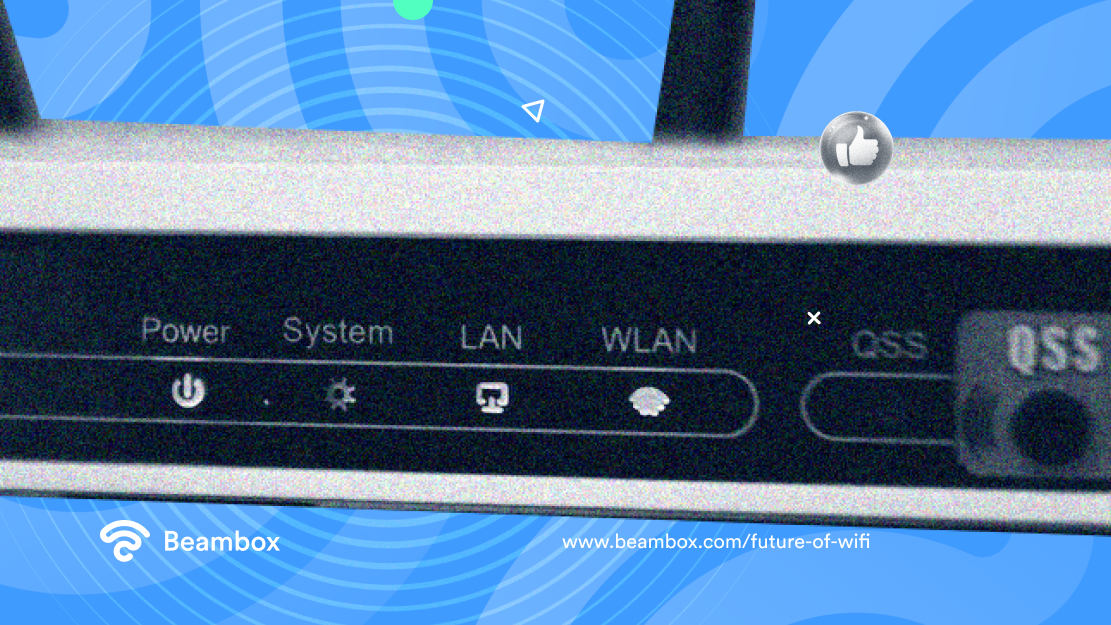Future of WiFi – Current Trends Shaping It
Can you imagine a world without WiFi? WiFi technology has become a critical part of our daily lives. According to research, there are 5.25 billion internet users worldwide or 66.2% of the total world population.
What Does WiFi Stand For? It stands for Wireless Fidelity and refers to wireless networking technology commonly used for internet access. WiFi is like oxygen: we don’t see it, but we know it’s there. It is essential to connectivity, the way oxygen is to life. Yes, it is almost impossible to think of a WiFi-less world. But what about the future of WiFi?

How does WiFi work? WiFi works by transmitting data wirelessly, allowing devices to connect to the internet without needing physical cables.
WLAN vs WiFi: WLAN, short for Wireless Local Area Network, refers to the network technology that allows devices to communicate wirelessly within a limited area, whereas WiFi specifically denotes the wireless networking standard that enables high-speed internet access within that network.
WiFi is essential in today’s society; we can’t help but think about the future of WiFi. With WiFi lies our ability to connect to the internet. This technology enables our devices, such as smartphones, laptops, and tablets, to connect to the world without needing a physical cable.
WiFi has dramatically increased the convenience and flexibility of communication. It is now vital in many areas, such as education, business, and personal use.
Let’s see a preview of WiFi in the future.
What Is the Future of WIFI?
Many people ask “Is WiFi internet?” WiFi technology has been a progressive and vibrant development area since the early 1970s. That is why we can expect the future of WiFi to include continued advancements.
We expect developments in speed and coverage, as well as new applications and uses. What is the future of WiFi in these areas?
Here’s what the future of WiFi looks like.
Faster Speed and Improved Capacity in the Future of WiFi
The widespread adoption of WiFi 6 and WiFi 7 will bring even higher speeds and improved capacity for handling multiple devices. The future of WiFi will be faster and more furious.
WiFi 6 (802.11ax) and WiFi 7 (802.11be) are the latest versions of the WiFi standard. Both provide speed and capacity and better performance in crowded areas. WiFi 6 is already available and being adopted, while WiFi 7 is still developing.
WiFi 5 vs WiFi 6: One of the main improvements in WiFi 6 is increased speed. WiFi 6 has a theoretical maximum speed of up to 9.6 Gbps, compared to 3.5 Gbps for WiFi 5 (802.11ac). WiFi 6 can handle more data at once. This speed makes it ideal for high-bandwidth activities such as streaming 4K video or gaming.
Another critical improvement in WiFi 6 is better capacity. We mean WiFi 6 can handle more devices on a network at once. WiFi 6 uses a technique called Orthogonal Frequency-Division Multiple Access (OFDMA). Multiple devices can share the same channel, reducing congestion and improving overall performance. WiFi frequency determines the speed and range of your wireless connection, with 2.4 GHz offering broader coverage and 5 GHz providing faster speeds.
Meanwhile, WiFi 7 has a maximum speed of up to 30 Gbps and uses “multi-gigabit wired and wireless access.” This speed assures improved capacity and coverage and allows devices to communicate seamlessly, even in crowded environments.
More Stable and Reliable Connections
When setting up Wi-Fi, consider what devices should be on 2.4GHz and 5GHz for optimal performance based on range and speed needs. Ensure your devices are connected to the appropriate WiFi frequency range for optimal performance, whether it’s 2.4GHz for coverage or 5GHz for speed. In the future of WiFi, further development of mesh networks will extend the coverage of WiFi networks. Mesh networks will also provide more stable and reliable connections.
Mesh networks extend the coverage of a WiFi network. Using multiple devices, or “nodes,” mesh networks create a more extensive, resilient grid. Each node acts as a relay for other nodes in a mesh network. Data is forwarded between nodes until it reaches its destination.

In this setup, the data is passed from node to node instead of relying on a single router. The design allows for a larger coverage area and better signal strength.
One of the critical benefits of mesh networks is that networks can expand quickly. Additional nodes installed in the network can increase coverage as needed. The design makes mesh networks ideal for larger homes or offices. Mesh networks can also work where traditional WiFi routers may need help to reach all areas.
Mesh networks also offer improved reliability. If one node goes down, the network can automatically route data around it, ensuring it remains up and running. The other nodes will still be able to communicate and maintain the network.
In the future of WiFi, dead spots in an establishment will be a thing of the past.
Another critical advantage of mesh networks is the ability to prioritize channel bandwidth to specific devices. This ability to prioritize is functional when certain devices require more bandwidth than others.
The Internet of Things in the Future of WiFi
The future of WiFi sees the integration of WiFi into new areas. These areas include the Internet of Things (IoT), smart cities, and connected cars. This development will require low-power, long-range, and secure wireless WiFi connections.
WiFi is a widely adopted wireless technology. It is well-suited for connecting a wide range of devices and sensors. This connectivity makes WFi an ideal choice for IoT applications.
In smart cities, WiFi networks connect many devices and sensors, such as traffic lights, parking meters, and public transportation systems. This connection enables real-time monitoring and control of these systems, improving efficiency and reducing congestion. For example, the system could adjust traffic lights in real time based on traffic flow. Parking spots could be designated for electric cars, allowing easy charging.

IoT will use WiFi in connected cars to connect a wide range of sensors, cameras, and other devices. These devices include navigation and infotainment systems. This system will enable real-time monitoring of the car’s systems, such as tire pressure, fuel level, and engine performance.
IoT will also allow cars to communicate with each other and with traffic lights, parking garages, and other infrastructure. Wouldn’t that improve safety and reduce congestion?
Emergence of New Technologies in the Future of WiFi
The emergence of new technologies will touch on the future of WiFi. LiFi, which uses light waves to transmit data, will provide an alternative to radio-based WiFi in certain situations.
LiFi is a new wireless communication technology that uses light waves instead of radio waves to transmit data. LiFi is considered an alternative and complementary technology to WiFi. It can be integrated with existing infrastructure and used in areas where radio waves are not allowed or feasible. These areas may include hospitals, airplanes, and nuclear power plants.
LiFi technology has the potential to provide faster internet speeds and more secure connections than WiFi. LiFi can transfer data at a rate of up to 10 Gbps faster than WiFi 6 (9.6 Gbps). LiFi is less susceptible to interference from other wireless devices too. Thus, it can provide a more secure connection as it is harder to intercept the signal.
However, LiFi has some limitations. LiFi requires a direct line of sight between the transmitter and the receiver. The signal will not pass through walls, limiting its functionality to specific environments such as large buildings or outdoor environments.
In conclusion, the emergence of LiFi technology may affect the future of WiFi. However, it’s still limited to specific environments. LiFi is limited to areas where radio waves are not allowed or not feasible. WiFi will still be the primary wireless communication technology in most environments.
Rise of Artificial Intelligence in the Future of WiFi
Using artificial intelligence WiFi technology can optimize your network performance and improve connectivity for your business. The increased use of AI and machine learning in WiFi networks brings significant improvements in the future of WiFi. AI and machine learning can optimize and improve the performance of WiFi networks, making them faster, more reliable, and more efficient.
One of the critical ways WiFi networks will use AI and machine learning is in the management of the network. AI algorithms can analyze network traffic, detect patterns and anomalies, and automatically adjust network settings to optimize performance. This automatic adjustment can reduce network congestion and improve the overall user experience.

AI and machine learning can also improve the security of WiFi networks. AI algorithms can detect and prevent cyber threats in real time by analyzing network traffic and identifying patterns. This detection will help protect the network from hackers and other malicious actors.
Another potential application of AI and machine learning in WiFi networks is optimizing device connections. AI algorithms can analyze device usage patterns and optimize the link to each device. These algorithms ensure that each device receives the appropriate channel bandwidth.
WiFi Router Offers in the Future
Soon, routers will offer a wide range of features and capabilities beyond just providing wireless internet access. Some routers for marketing software also offer social network functions. These offers will leverage developments in the future of WiFi.
Some potential WiFi router offers to include:
-
Smart Home integration: Integrate routers with smart home devices and platforms. This integration will allow for easy control and automation of connected devices.
-
Advanced security: Routers may include more advanced security features such as built-in VPNs, firewalls, and malware protection. These features will keep your network and devices safe.
-
Parental controls: Routers may have advanced features to help parents control and monitor their children’s internet usage.
-
Quality of Service (QoS) management: Routers may offer advanced QoS management features. This feature helps prioritize bandwidth for different types of traffic, such as video streaming or online gaming.
-
AI-assisted network management: Routers may use machine learning and AI to optimize network performance and troubleshoot issues.
-
IoT integration: Routers can connect and manage multiple devices with low-power, long-range, and secure wireless connections.
In summary, companies produce new WiFi routers yearly to keep abreast with current developments in WiFi and 5G technology. It is important to choose the latest router models that offer smart home integration, advanced security, and parental control as basic features.
In addition, routers offering Quality of Service (QoS), AI-assisted network management, and Internet of Things (IoT) have the edge over other offers.

Routers in the future may offer a wide range of features and capabilities. Routers will go beyond just providing wireless internet access, making them more versatile and user-friendly.
What Is the Future of 5G Technology?
5G is the fifth generation of mobile wireless technology currently deployed worldwide. It offers much faster speeds and lower latency than previous generations of mobile technology.
What is the future of 5G technology? Like WiFi 6, 5G technology supports the growing number of devices and the increasing demand for high-speed, low-latency connectivity. 5G provides wide-area mobile connectivity, while WiFi 6 provides high-speed, short-range wireless connectivity. In the future of WiFi, these technologies will enable a wide range of new applications and services.
Some potential developments in the future of 5G include:
-
Broader coverage and adoption: 5G networks continue to roll out and expand, providing range to more areas and reaching more users.
-
Increased capacity: 5G networks support even more devices and handle more data traffic.
-
Lower latency: 5G networks have lower latency, enabling new use cases such as virtual reality, autonomous vehicles, and industrial automation.
-
Enhanced Mobile Broadband (eMBB): The Enhanced Mobile Broadband services that 5G brings will become widely available and popular.
-
IoT integration: 5G networks support many IoT devices and use cases, including industrial IoT, smart cities, and connected cars.
-
Network slicing: 5G networks may utilize the concept of Network slicing. In this concept, the system creates different logical networks on top of the same physical infrastructure. Each structure has specific characteristics and policies and caters to particular use cases and industries.
Overall, mobile wireless technology is a vibrant field that continues to develop. It is important for businesses and organizations need to anticipate developments to equip themselves with scalable infrastructure that can receive new technological releases.
Equip Your Business Now for the Future of WiFi
As you can see, businesses can prepare this early for the future of WiFi. As WiFi and 5G technology continue developing, marketing software will follow suit.
Resilient and scalable marketing software can help you prepare for the future and grow your revenues simultaneously.
Small business owners need marketing features and an effective, efficient, and within-budget software solution.
Beambox’s digital marketing solution can help you get the most out of reviews, contact lists, and customer information. Beambox can help you plan, monitor, and redirect your marketing efforts to grow your business.
Learn more about Beambox and start growing your business now.
Get Started With Free WiFi Marketing
Beambox helps businesses like yours grow with data capture, marketing automation and reputation management.
Sign up for 30 days free


